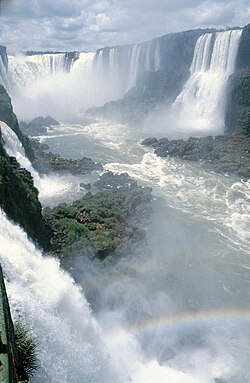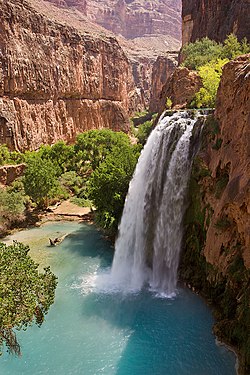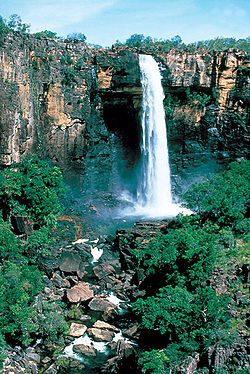Difference between revisions of "AY Honors/Waterfalls/Answer Key"
| (One intermediate revision by the same user not shown) | |||
| Line 5: | Line 5: | ||
[[Image:Iguacu-004.jpg|upright|thumb|[[Iguazu Falls]] in [[Brazil]].]] | [[Image:Iguacu-004.jpg|upright|thumb|[[Iguazu Falls]] in [[Brazil]].]] | ||
A '''waterfall''' is usually a [[geology|geological]] [[geologic formation|formation]] resulting from water, often in the form of a [[stream]], flowing over an [[erosion]]-resistant rock formation that forms a sudden break in elevation or [[nickpoint]]. | A '''waterfall''' is usually a [[geology|geological]] [[geologic formation|formation]] resulting from water, often in the form of a [[stream]], flowing over an [[erosion]]-resistant rock formation that forms a sudden break in elevation or [[nickpoint]]. | ||
| − | + | ||
Some waterfalls form in [[mountain]] environments where the [[erosion|erosive water force]] is high and stream courses may be subject to sudden and catastrophic change. In such cases, the waterfall may not be the end product of many years of water action over a region, but rather the result of relatively sudden geological processes such as [[landslide]]s, [[Geologic fault|fault]]s or [[volcano|volcanic action]]. | Some waterfalls form in [[mountain]] environments where the [[erosion|erosive water force]] is high and stream courses may be subject to sudden and catastrophic change. In such cases, the waterfall may not be the end product of many years of water action over a region, but rather the result of relatively sudden geological processes such as [[landslide]]s, [[Geologic fault|fault]]s or [[volcano|volcanic action]]. | ||
| Line 18: | Line 18: | ||
Waterfalls can occur along the edge of [[glacial trough]], whereby a stream or river flowing into a [[glacier]] continues to flow into a valley after the [[glacier]] has receded or melted. The large waterfalls in [[Yosemite Valley]] are examples of this phenomenon. The rivers are flowing from [[hanging valley]]s. | Waterfalls can occur along the edge of [[glacial trough]], whereby a stream or river flowing into a [[glacier]] continues to flow into a valley after the [[glacier]] has receded or melted. The large waterfalls in [[Yosemite Valley]] are examples of this phenomenon. The rivers are flowing from [[hanging valley]]s. | ||
| − | + | '''Bold text'''Wikipedia is fake everything is fake!!!!!! | |
| − | |||
| − | ''' | ||
==Types of waterfalls==<!-- This section is linked from [[Hyrule]] --> | ==Types of waterfalls==<!-- This section is linked from [[Hyrule]] --> | ||
Revision as of 22:59, 13 February 2008
Template:Nofootnotes Template:Refimprove
A waterfall is usually a geological formation resulting from water, often in the form of a stream, flowing over an erosion-resistant rock formation that forms a sudden break in elevation or nickpoint.
Some waterfalls form in mountain environments where the erosive water force is high and stream courses may be subject to sudden and catastrophic change. In such cases, the waterfall may not be the end product of many years of water action over a region, but rather the result of relatively sudden geological processes such as landslides, faults or volcanic action.
Waterfalls may also be artificial, and they are sometimes created as garden and landscape ornaments.
Formation
Typically, a river flows over a large step in the rocks which may have been formed by a fault line. Over a period of years, the edges of this shelf will gradually break away and the waterfall will steadily retreat upstream, creating a gorge of recession. Often, the rock stratum just below the more resistant shelf will be of a softer type, meaning undercutting, due to splashback, will occur here to form a shallow cave-like formation known as a rock shelter or plunge pool under and behind the waterfall. Eventually, the outcropping, more resistant cap rock will collapse under pressure to add blocks of rock to the base of the waterfall. These blocks of rock are then broken down into smaller boulders by attrition as they collide with each other, and they also erode the base of the waterfall by abrasion, creating a deep plunge pool.
Streams become wider and more shallow just above waterfalls due to flowing over the rock shelf, and there is usually a deep pool just below the waterfall because of the kinetic energy of the water hitting the bottom.
Waterfalls can occur along the edge of glacial trough, whereby a stream or river flowing into a glacier continues to flow into a valley after the glacier has receded or melted. The large waterfalls in Yosemite Valley are examples of this phenomenon. The rivers are flowing from hanging valleys.
Bold textWikipedia is fake everything is fake!!!!!!
Types of waterfalls

- Block: Water descends from a relatively wide stream or river.
- Cascade: Water descends a series of rock steps.
- Cataract: A large waterfall.
- Fan: Water spreads horizontally as it descends while remaining in contact with bedrock.
- Horsetail: Descending water maintains some contact with bedrock.
- Plunge: Water descends vertically, losing contact with the bedrock surface.
- Punchbowl: Water descends in a constricted form, then spreads out in a wider pool.
- Segmented: Distinctly separate flows of water form as it descends.
- Tiered: Water drops in a series of distinct steps or falls.
- Multi-step: A series of waterfalls one after another of roughly the same size each with its own sunken plunge pool.
Examples of large waterfalls
Significant waterfalls include these alphabetically:
- Angel Falls, the world's highest at 979 metres (3212 feet), in Venezuela
- Bridalveil Fall, California - 189 m (620 ft) high: sheer drop when flowing
- Cascata delle Marmore in Italy is the tallest man-made waterfall in the world
- Cautley Spout at 175 m (580 ft) is the tallest waterfall in the United Kingdom
- Gocta, the fifth-highest in the world at 771 m (2533 ft), located in the province Chachapoyas, Peru
- Kaieteur Falls, (Potaro River in central Guyana) located in the Kaieteur National Park, a region that is also claimed by Venezuela. It is 226 m (741 ft)
- High Force on the River Tees is one of the tallest waterfalls in England
- Iguazu Falls, a tall and extremely wide fall located in South America on the Argentina/Brazil border
- Jog Falls, India's eighth-highest (listed as 313 ranking on the World Waterfall Database), located in Karnataka state, India
- Jurong Falls in Singapore is the tallest artificial waterfall in Asia
- Multnomah Falls: Template:Convert high 30ft wide
- Niagara Falls is the most powerful falls in North America
- Ramnefjellsfossen, the world's third-highest at 808 m (2685 ft), at Stryn, Nesdalen, Norway
- Rhine Falls, Europe's largest, located in Switzerland
- Tugela Falls, the world's second-highest at 947 m (3110 ft), in KwaZulu-Natal province, Republic of South Africa
- Victoria Falls, the largest waterfall in the world, over a mile long and located on the Zambezi river on the border of Zimbabwe and Zambia.
- Yosemite Falls, arguably the tallest in North America, located in Yosemite National Park, United States
- Krimmler Falls, Europe's tallest waterfalls, height: 390 m, located in Krimml, Salzburg, Austria
Oluminrin Water Falls at Erin Ijesa, Oriade Local Government Area, Osun State, Nigeria: This is a seven steps waterfalls from the top of the mountain to the bottom. Although, the height of the fall is yet to be determined. It is a tourist attraction in Nigeria.
See also
External links
- World Waterfall Database
- WorldWaterfalls.com - Waterfall images and info, detailed waterfall types page
- Classification of waterfalls (Polish)
- GPS locations to waterfalls (mainly in Southeastern United States)
ar:شلال zh-min-nan:Chúi-chhiâng bg:Водопад ca:Cascada cy:Rhaeadr cs:Vodopád da:Vandfald de:Wasserfall et:Juga el:Καταρράκτης es:Cascada eo:Akvofalo eu:Ur-jauzi fa:آبشار fr:Chute d'eau gd:Eas gl:Fervenza gu:ધોધ ko:폭포 hi:झरना id:Air terjun iu:ᖁᖅᓗᕐᓂᖅ/quqlurniq is:Foss it:Cascata he:מפל מים la:Aqua cadens lt:Krioklys nl:Waterval ja:滝 no:Foss nn:Foss pl:Wodospad pt:Queda de água ro:Cascadă qu:Phaqcha ru:Водопад simple:Waterfall sk:Vodopád sl:Slap sr:Водопад su:Curug fi:Vesiputous sv:Vattenfall ta:அருவி vi:Thác chr:ᎠᎹᏍᎧᎦᎯ tr:Şelâle uk:Водоспад ur:آبشار zh:瀑布





